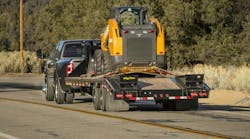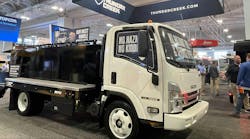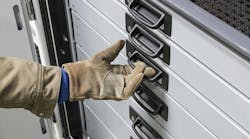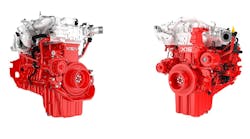Thunderbolt Marine, based on a 25-acre site on the Wilmington River in the town of Thunderbolt about three miles southeast of Savannah, provides dock space as well as repair and refurbishing services for large yachts. The Thunderbolt Marine facility, located on the Intracoastal Waterway, includes its own 800-foot by 600-foot boat basin, which allows large vessels using the marina the maneuvering room they need.
But the area picks up large quantities of silt — about 4 inches of silt each month in the basin itself. To keep the basin clear of silt and ensure that there is adequate depth, the marina must dredge the basin every two years or so.
"Our goal is to maintain it at minus 14 feet," notes Wayne Varner, Thunderbolt Marine's project manager.
Dealing With Dredge SpoilsEach dredging operation takes about six months to complete. What becomes of the dredge tailings? They're pumped to a 30-acre diked spoils retention area just a short distance from the Thunderbolt Marine facility.
The Corps of Engineers also has rights to use the spoils area during Intracoastal Waterway dredging operations, so maximizing the containment area's capacity is of critical importance.
The management plan for the spoils island calls for allowing dredged material to drain and dry within the basin; then, once the material has dried sufficiently, it is transported from the interior of the basin to the basin's perimeter, where it is in effect recycled and used to repair the surrounding dikes.
The challenge is this: How do you most efficiently load and transport the material from the basin to the dikes?
The Pull Pan SolutionAt first glance, it looks like an easy assignment. Once the dredged material has been allowed to dry, it appears to be nothing more than solid, dry dirt.
But appearances are deceiving. The fact is that the dry crust is just that — a crust with a thickness of just a foot or two. Beneath the crust is extremely soft muck — and that poses major challenges to anyone who wants to work atop the material with heavy equipment.
In the past, Thunderbolt Marine had dealt with the challenge by using off-road trucks loaded by excavators. But experience showed that the trucks tended to have problems with the soft muck that lay just beneath the surface, and Varner wanted to find a better way.
The solution came in the form of large Case MX210 agricultural tractors combined with IMC 15-yard pull pans, all modified with low ground pressure tires. Working with Savannah-based Stephen Plunk, general manager of C.L.S. Inc., Thunderbolt Marine's Varner began to put together the lineup of equipment that the site required. C.L.S., which specializes in rental, sales and service of pull pans and tractors, is a Case and New Holland ag line dealer and also offers pull pans from IMC, Reynolds, Miskin, Ashland, and Bigfoot.
Working Wet Or DryThe plan developed by Varner and Plunk called for using the tractors and pull pans to load the dry material from the settlement basin and transport it to the dikes that surround the containment area. When the material was too wet for the pans to self-load — for example, after a rain — the pans' self-loading capabilities would be supplemented by excavators, which would load the pans as if they were dump trucks.
"Dry material can be self-loaded by the pans," Plunk says, "but even wet material can still be moved if the excavators load the pans."
The excavators were also used during construction of drain fields, which utilize sock drains to provide more effective drainage and deeper drying of the spoils material.
Plunk adds that proper sizing of machines was important on this job.
"The key is to match the size of the pan to the size of the tractors," notes Plunk, adding, "In an application like this one, bigger pans are not necessarily better." Because of the challenging nature of the terrain, he explains, the smaller pans are able to load and travel more quickly.
"And that means total production goes up," Plunk says.
Equipment Delivery By BargeThe tractors and pans, as well as other machines used during this phase of the work, were transported to the island on a barge. Machines were loaded onto the barge at port facilities on nearby Hutchinson Island for the trip over water to the spoils island. Once at the island, the equipment disembarked at a barge landing site that has been constructed on one end of the island.
Additional support is provided by the "Mitey Mouse," a service boat which shuttles between the Thunderbolt Marina facility and the nearby spoils island.
In addition, during work within the basin, about 500 gallons of fuel is delivered to the island every couple of days.
Tire InnovationTo work most effectively in this challenging environment, Plunk configured the tractors with large flotation tires. That allows them to work effectively in the soft material — and to give the tractors maximum traction in the frequently soft material, Plunk says, "We turned the tires around so that the treads are backwards."
The idea of using backwards-mounted tires was born, Plunk says, when he and Varner began discussing ways to increase traction while providing additional flotation in the tough material.
"By turning the directional tires around," Plunk says, "the tires are able to pull material to the center of the tire instead of pushing it out to the edges. That gives additional flotation and does not dig into the soft ground nearly as fast as the normal tire orientation would do."
The pull pans used on the job were ordered with optional LGP tires. To use LGP tires on the tractors, however, C.L.S. had to have special tractor rims fabricated by Southern Wheel and Tire in Jacksonville, Fla. But even with the large flotation tires, the tractor operators had to pay constant attention to where they ran.
"To help deal with the soft conditions, we had to build the main haul road on mats," Varner says, adding, "On a site like this, you just don't get off those mats."
The first dikes were built at the site in the mid 1970s, and as the area has continued to be used the dikes have been regularly repaired to provide additional capacity. These low ground pressure tractors and pull pans should go a long way toward helping Thunderbolt Marine to continue using the site for many years to come.




